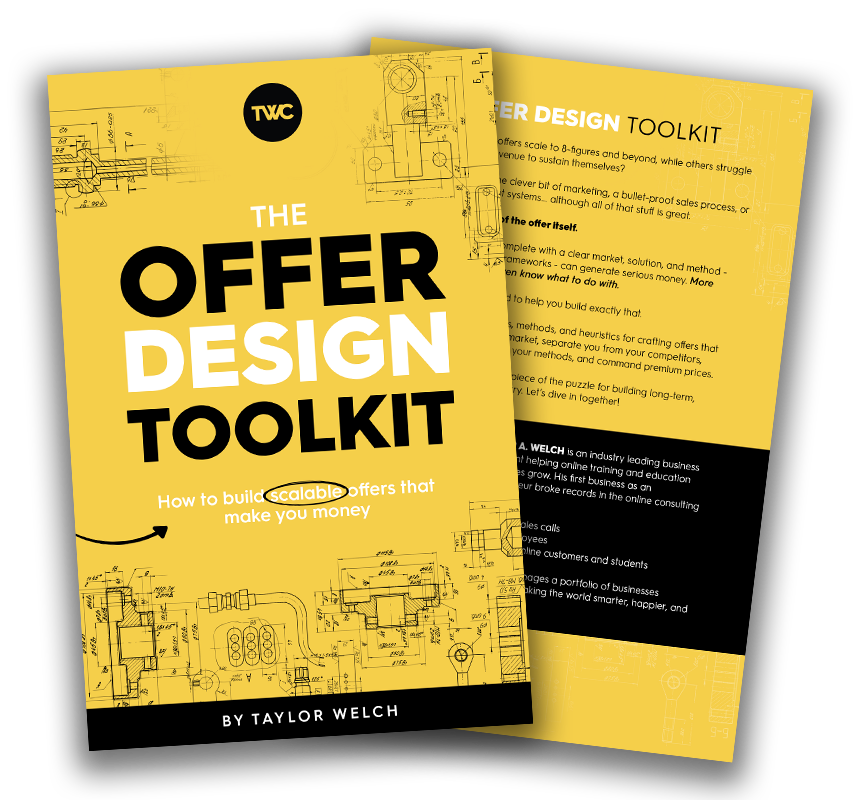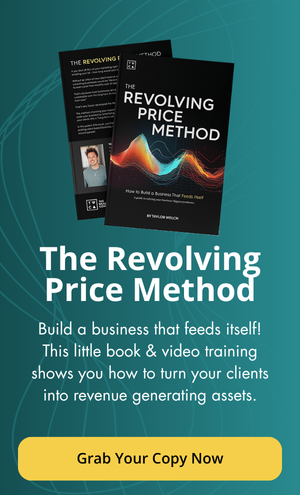Packaging as a Bridge to the Market
Packaging is not fluff.
It is the bridge between what you know (the value you deliver) and how your market experiences it.
We have seen it a thousand times: entrepreneurs with immense knowledge and the ability to create insane results for their market… but, somehow… they have no clients.
Their skill is not the problem. Their processes are not the problem. The market is certainly not the problem (though, many will try relentlessly to make it seem that way). If people only understood what this person was capable of helping them do, they would be tripping over themselves to hand them their credit card.
AHA. Found the problem.
“IF people UNDERSTOOD…”
The fact that they don’t points out the culprit immediately.
They’ve got the goods, they’ve got the results to deliver. What they lack is a succinct, cohesive and well-packaged offer that sells those goods to a hungry public.
Today we are going to show you three packaging levers that turn good offers into irresistible ones.
#1. The Powerful P3 Framework
Every great offer begins with a problem your client desperately wants to solve. But identifying the problem is not enough. You must amplify the pain of leaving it unsolved and link that pain directly to the cost of inaction. People rarely change when they are comfortable; they change when staying the same becomes unbearable.
Once you have drawn this line, price becomes a reflection of value rather than cost. Clients will happily pay more for a solution that feels urgent, transformative, and tailored to them. When packaging your offer, make sure prospects understand not just what you do, but also what happens to their life or business if they do nothing.
This is the P3 Framework – Problem, Pain, and Price.
Let’s do a quick example. Say you’re a fertility specialist, and you help couples who are struggling to conceive get pregnant.
- Problem – The couple can’t get pregnant, despite trying for years.
- Pain – EXTREMELY HIGH. It’s what they spend a majority of their day thinking about. It causes fights, frustrations, sadness, fear, anxiety. The “pain price tag” of this issue is immense.
- Price – If, at the end of their life, someone offered them the ability to use a time machine to go back and fix the problem, how much would they be willing to PAY to do so? For a couple struggling with infertility, they would literally empty their bank account if it meant getting to hold that baby in their arms.
When viewed through this lens, you get absolute clarity on how good of an offer you really have, and how well positioned you can make it in your marker.
For a deeper dive into diagnosing whether your offer is hitting these marks, check out our article on Diagnosing Your Offer: What To Do When It’s Not Working.
#2. Make Packaging Work Like a Multiplier
A great offer poorly packaged will always underperform.
A decent (or even mediocre) offer packaged brilliantly can outsell it ten to one. Packaging is what gives your offer price elasticity. What do we mean when we say that? Offer price elasticity is the ability to raise rates confidently without raising objections.
What does effective packaging include?
- Specific positioning that makes the offer feel exclusive and bespoke to the prospective buyers.
- Visuals or metaphors that allow the client to picture themselves inside the solution.
- A clear, concise, easy to follow explanation of how the process works.
That last one is a biggie. When a prospect sees the offer process outlined in simple, crystal clear language, with a bankable timeline and step-by-step instructions, it does more than just help them understand. It builds confidence, trust, and excitement for the solution.
Think of the legendary Rolls-Royce ad: “At 60 miles an hour the loudest noise is the ticking of the clock.” That is packaging. It creates an experience in the buyer’s mind before they ever touch the product.
In consulting, this means taking your core expertise and wrapping it in a framework, process, or signature method that prospects can see, understand, and desire.
Want to go deeper into how to build that framework? Read 3 Keys to Building a Profitable Offer Around Your Expertise.
#3. The Specificity Razor
Raising the perceived value of an offer only steps from specificity.
Broad offers compete on price because they sound like everything else. The broader you go, the more you’ll be forced to race your competition to the bottom when it comes to price.
Specific offers compete on value because they speak directly to a particular someone in a particular situation.
Think of it this way: A general, family practitioner and a brain surgeon are both doctors, right? But, who do you think makes more? If you answered “the brain surgeon,” you’d be right.
But why? Specificity… specialization. Specialists always get paid more than generalists.
For example, “helping business owners grow” is generic. “Helping healthcare providers erase 10 years of student loan debt so they can open their own practice” is specific.
The second one not only commands higher prices, it also attracts clients who are motivated and ready to act. Specificity shrinks your audience but dramatically increases your conversion rate and profit margins.
Narrow your message, and you will widen your impact.
From Selling to Attracting
Packaging is not just what you say about your offer, but how your prospects experience it. When you clarify the problem and pain, wrap it in an irresistible package, and laser in on specificity, you stop selling and start attracting.
The difference between an offer that collects dust and an offer that collects revenue is the way you package it.

Get Our Offer Design Toolkit
We compiled a series of lessons about building and packaging profitable consulting offers inside of our little gem of a book, “The Offer Design Toolkit.” The lessons you will learn in this book, far exceed much of what is taught in most other $97 (or even $997) courses on the same topic. From the P3 framework and packaging strategies, to the marketing positioning models we teach our clients to get a unique advantage in the marketplace – this book is big on value but small on price tag. You can have it today for $3.

